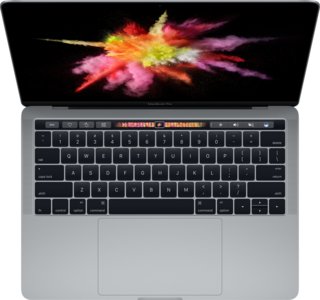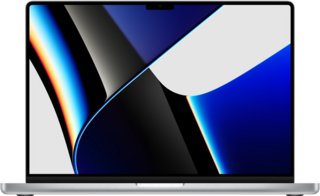Apple MacBook Pro (2017) 13" with Touch Bar and Touch ID / Intel Core i5 256GB vs Apple MacBook Pro (2021) 14.2" Apple M1 Pro 10-core
Trying to decide which MacBook Pro model suits you best? Let's compare the 2017 MacBook Pro 13" with Touch Bar and Touch ID to the 2021 MacBook Pro 14.2.
The 2017 model is fitted with an Intel Core i5 processor that operates at 3.1GHz, supported by 8GB of RAM and a solid-state drive with a capacity of 256GB. However, the more recent 2021 variant comes with an Apple M1 Pro chip that features a design for improved computing power. In addition to that, it ups the ante on RAM with a substantial 16GB and offers a significant four-fold increase in storage space compared to its predecessor at 1TB.
What sets these two apart? The performance leap is quite noticeable, with the M1 Pro chip in the newer model offering faster processing speeds and better efficiency than its Intel counterpart. Additionally, the expanded memory and storage allow it to handle more intensive tasks effortlessly. Also, its larger screen size of 14.2" provides extra workspace, augmented by a sleeker design.
Both models have some similarities worth noting. For instance, they both boast high-quality Retina displays and sturdy build quality—a standard feature in Apple products.
Whether you prioritize powerful performance for creative projects or seek a reliable machine for everyday use, comprehending these distinctions and similarities will help you select the MacBook that best fits your needs.
System and application performance
Performance in popular 3D games
Viewing angle, color accuracy...
Ports, webcam and other interfaces
Potential battery life
Materials, durability and portability
Design Comparison
Size Comparison
Comparison of Design: Apple MacBook Pro 13" (2017) vs. Apple MacBook Pro 14.2" (2021)
Ergonomics and Portability
- MacBook Pro 13" (2017)
- Weight: 3 pounds
- Measurements: 12 inches in width, 8.4 inches in height, and 0.6 inches in thickness.
- MacBook Pro 14.2" (2021)
- Weight: 3.5 pounds
- Size: Measuring at 12.3" in width, 8.7" in height, and 0.6" in thickness.
Insights:- The MacBook Pro (2021) features a slightly larger and heavier design to accommodate the expanded screen size.- Both models are slim and portable while being durable.
Materials and Build Quality
- Both Models
- Aluminum construction provides a sleek and durable design.
Insights:Apple's commitment to using premium materials results in a stylish design and durable build, attracting students and professionals in search of a dependable device.
Unique Design Features
- MacBook Pro 13" (2017)
- Features include a backlit keyboard, support for USB Type-C, Wi-Fi compatibility, Thunderbolt ports, and stereo speakers.
- MacBook Pro 14.2" (2021)
- HDMI output, USB Type-C ports, Wi-Fi support (including Wi-Fi 6), external memory slot, extra Thunderbolt ports, MagSafe power adapter.
Insights:- The MacBook Pro (2021) offers more connectivity options such as HDMI output, additional USB ports, and the reintroduction of the MagSafe power adapter to improve user convenience across different situations.The newer model features enhanced Wi-Fi support for quicker wireless connections, ensuring smooth online experiences.
Usability Enhancements
- Both Models
- Backlit keyboards for typing in low-light environments.
- Fingerprint scanners for secure login.
- Front cameras for video calls.
- Voice command features enable hands-free operation.
Insights:- Biometric security features, like fingerprint scanners, improve both data protection and user convenience.Voice commands provide a convenient hands-free control option for professionals who require multitasking capabilities or students seeking efficient workflow management.
Aesthetic Appeal
Both Models: Sleek design featuring slim bezels that enhance the viewing experience.
Insights:Apple keeps its distinctive minimalist design consistent across both models, appealing to users who prioritize aesthetics as well as performance.
Conclusion: The MacBook Pro (2017) features a compact design with essential USB Type-C and Thunderbolt ports. The MacBook Pro (2021) advances connectivity with additional ports like HDMI and Wi-Fi 6 support. For users prioritizing better connectivity and modern design, the MacBook Pro (2021) is a strong choice.
Screen Comparison
| Apple MacBook Pro (2017) 13" with Touch Bar and Touch ID Intel Core i5 256GB | Apple MacBook Pro (2021) 14.2" Apple M1 Pro 10-core | |
|---|---|---|
| Resolution | QHD | QHD |
| Screen Size | 13.3" | 14.2" |
Comparing Laptop Screens: Apple MacBook Pro (2017) 13" vs. Apple MacBook Pro (2021) 14.2
When comparing the screen features of the Apple MacBook Pro (2017) 13" and the Apple MacBook Pro (2021) 14.2", noticeable differences arise that notably affect user experience, particularly in activities such as gaming or professional graphic design.
Screen Size:
- MacBook Pro (2017): 13.3 inches
- MacBook Pro (2021): 14.2-inch display.
Implication: The larger screen size of the MacBook Pro (2021) offers more screen space for multitasking, immersive gaming experiences, and detailed graphic design tasks. This increased size can boost productivity by enabling improved organization of windows and tools.
Screen Resolution:
- MacBook Pro (2017): 2560 x 1440 px
- MacBook Pro (2021): 3024 x 1080 px
Implication: The improved resolution on the MacBook Pro (2021) provides crisper images, text, and graphics than its previous model. This is especially advantageous for tasks such as photo editing or video production that demand exact visual precision, ultimately elevating content clarity and quality.
Pixel Density:
- MacBook Pro (2017): 227 ppi
- MacBook Pro (2021): 254 ppi
Implication: The MacBook Pro (2021) boasts a higher pixel density, delivering sharper visuals with smoother gradients, clearer text, and finer details. This upgrade enhances the visual experience for gaming and intricate design projects alike.
Display Technology:
- MacBook Pro (2017): IPS LCD LED-backlit
- MacBook Pro (2021): LED-backlit LCD
Implication: Both models feature LED-backlit displays for vibrant colors and energy efficiency. The switch to this technology in the newer model may lead to improved brightness levels and color accuracy, contributing to better visual fidelity in games and ensuring accurate color representation in design workflows.
Brightness:
- MacBook Pro (2021): Brightness rated at 1000 nits
The enhanced brightness level of the MacBook Pro (2021) improves visibility in well-lit environments and outdoors, benefiting professionals working under different lighting conditions or gamers looking for a glare-free viewing experience.
In summary, both laptops boast high-quality screens suitable for different tasks. However, the Apple MacBook Pro (2021) emerges as the top choice for users involved in demanding activities such as gaming or professional graphic design due to its larger size, higher resolution, pixel density, and enhanced brightness.
Hardware Comparison
| Apple MacBook Pro (2017) 13" with Touch Bar and Touch ID Intel Core i5 256GB | Apple MacBook Pro (2021) 14.2" Apple M1 Pro 10-core | |
|---|---|---|
| CPU | Intel Core i5 | Apple M1 |
| RAM | 8GB | 16GB |
| Storage Size | 256GB | 1000GB |
Comparing the hardware specifications of the Apple MacBook Pro (2017) 13" with Touch Bar and Touch ID, which includes an Intel Core i5 processor, 8GB RAM, and 256GB storage, to the Apple MacBook Pro (2021) 14.2" featuring the advanced Apple M1 Pro chip, 16GB RAM, and a generous 1TB SSD, reveals significant differences.
CPU:
- The MacBook Pro (2017) uses an Intel Core i5 3.1GHz processor with 4 threads.The MacBook Pro (2021) stands out with its advanced Apple M1 Pro chip, featuring a 10-core CPU that can reach speeds up to 8 GHz.
Performance Impact:The new M1 Pro chip outperforms and operates more efficiently than the older Intel Core i5, particularly in tasks such as video editing or 3D rendering that rely on multi-core processing.
GPU:
- The MacBook Pro (2017) includes Intel integrated graphics.The MacBook Pro (2021) seamlessly incorporates robust graphics capabilities within the M1 Pro chip.
Performance Impact:The M1 Pro chip's integrated GPU boosts graphics performance for demanding applications like gaming or professional design software.
RAM:
- The MacBook Pro (2017) features 8GB of RAM operating at 2133 MHz.
- The MacBook Pro (2021) provides double the RAM capacity compared to its predecessor, featuring 16GB.
Performance Impact:- Increasing the amount of RAM enhances multitasking efficiency, particularly for memory-intensive activities such as operating multiple virtual machines or working on large files concurrently.
Storage:
- The MacBook Pro (2017) is equipped with a 256GB flash storage drive.
- In contrast, the MacBook Pro (2021) features a notably larger 1TB SSD storage capacity.
Performance Impact:
- The increased storage capacity in the newer model enables users to store more data locally without compromising on speed, ideal for professionals dealing with large media files or complex software installations.
Overall Performance Comparison:
- The latest MacBook Pro model showcases impressive performance improvements with the Apple M1 Pro chip, excelling in CPU, GPU, and power efficiency over the previous version.
Conclusion: For users using demanding multimedia applications like video editing or graphic design, the latest Apple MacBook Pro (2021) with upgraded hardware is a smart investment. If you have budget constraints and mostly perform lighter tasks such as web browsing or document editing, the older Apple MacBook Pro (2017) can still meet your needs well.
Battery Comparison
| Apple MacBook Pro (2017) 13" with Touch Bar and Touch ID Intel Core i5 256GB | Apple MacBook Pro (2021) 14.2" Apple M1 Pro 10-core | |
|---|---|---|
| Battery Life | 10 hours | 11 hours |
When comparing the battery performance of the Apple MacBook Pro (2017) 13" with Touch Bar and Touch ID, equipped with an Intel Core i5 processor, 8GB RAM, and a 256GB SSD, to that of the Apple MacBook Pro (2021) 14.2" powered by an Apple M1 Pro 10-core chip, 16GB RAM, and a 1TB SSD, there are notable distinctions to take into account.
Apple MacBook Pro (2017) 13"
- Battery Life: 10 hours
Apple MacBook Pro (2021) 14.2"
- Battery Life: 11 hours
- Sleep And Charge USB Ports: true
- MagSafe Power Adapter: true
The latest Apple MacBook Pro (2021) boasts an enhanced battery life compared to the previous model, offering users an additional hour of usage for extended productivity or entertainment on-the-go.
The 2021 model now includes Sleep And Charge USB Ports, enabling convenient charging of external devices while the laptop is in sleep mode. This addition boosts usability and enhances the laptop's functionality.
The MagSafe Power Adapter has returned in the latest MacBook Pro, offering a familiar and secure way to charge the device. Its magnetic connection minimizes accidental disconnections, providing added convenience for users who appreciate ease of use.
In conclusion, the Apple MacBook Pro (2021) surpasses its predecessor with an additional hour of battery life and user-friendly features such as Sleep And Charge USB Ports and a MagSafe Power Adapter, enhancing overall user experience.
Verdict
Why Apple MacBook Pro (2017) 13" with Touch Bar and Touch ID Intel Core i5 256GB?
- Budget-friendly option with performance suitable for everyday tasks.
- Slimmer and more portable design for on-the-go use.
- Retains essential ports like USB Type-C and Thunderbolt for versatile connectivity.
Why ?
- The Apple MacBook Pro (2021) with M1 Pro chip offers significantly faster processing and better efficiency compared to the Intel Core i5 in the 2017 model.
- The 2021 MacBook Pro provides double the RAM and four times the storage capacity, making it ideal for intensive tasks.
- With a larger 14.2" screen, the 2021 model offers more workspace and a sleeker design for enhanced user experience.
Similar comparisons
- Apple MacBook Pro (2017) 13" with Touch Bar and Touch ID / Intel Core i5 256GB vs Apple MacBook Pro (2020) 13" Intel Core i5 1.4GHz 8GB RAM 512GB SSD
- Apple MacBook Pro (2017) 13" with Touch Bar and Touch ID / Intel Core i5 256GB vs Apple MacBook Pro (2020) 13.3" Apple M1
- Apple MacBook Air (2022) 13.6" Apple M2 8-core vs Apple MacBook Pro (2021) 14.2" Apple M1 Pro 10-core
- Apple MacBook Pro (2016) 15" with Touch Bar and Touch ID vs Apple MacBook Pro (2021) 16.2" Apple M1 Max
- Apple MacBook Pro (2016) 13" vs Microsoft Surface Laptop 4 13.5"

